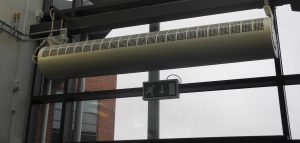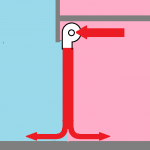 In situations where it is necessary to keep a building’s outer doors open, you will sometimes find “air curtains”, fans which blow a sheet of air down across the width of the doorway. These are an effective way of preventing dust and insects getting in through the door: they are entrained in the outer layer of airflow, and where the jet hits the floor it splits, with the outer layer discharging the contaminants back outside.
In situations where it is necessary to keep a building’s outer doors open, you will sometimes find “air curtains”, fans which blow a sheet of air down across the width of the doorway. These are an effective way of preventing dust and insects getting in through the door: they are entrained in the outer layer of airflow, and where the jet hits the floor it splits, with the outer layer discharging the contaminants back outside.

Some suppliers of air curtains claim that they conserve energy as well. The basis of this claim lies in what would naturally happen in an open doorway in still conditions, namely convective circulation in which warm air at high level flows out to be balanced by cold air flowing inwards at low level (right). This effect will be especially marked with high doorways. The claim for air curtains is that they disrupt the flow of escaping warm air, forcing it down to floor level where the jet splits, with the warm inner layer returning inside.
 However, even in still conditions there is a problem here, because the fan is drawing air from high level inside and at floor level only half of it returns inside. 50% of the internal air drawn into the fan is diverted outside when the jet splits at floor level (left).
However, even in still conditions there is a problem here, because the fan is drawing air from high level inside and at floor level only half of it returns inside. 50% of the internal air drawn into the fan is diverted outside when the jet splits at floor level (left).
A further problem with pedestrian doorways particularly is that the air curtain usually needs heating to prevent the perception of cold that the air’s velocity would create. If the building actually doesn’t need that heat, it is all a waste of money. Even if it does need the heat, half of what is put in goes straight outside.
In windy conditions the argument for air curtains as heat barriers really breaks down. A moving sheet of air is simply not as effective as a door. If there is any differential pressure whatever, that sheet of air will be displaced, and the problem is exacerbated if there are open doors or windows on the far side of space – or extract fans. In one instance I visited a restaurant that operated an open-door policy. Their air curtain had a 20kW heater that ran continuously, but the downjet did not reach the floor: about 60cm above the floor it turned inwards along with a layer of cold air at floor level, thanks to the kitchen extract depressurising the space.